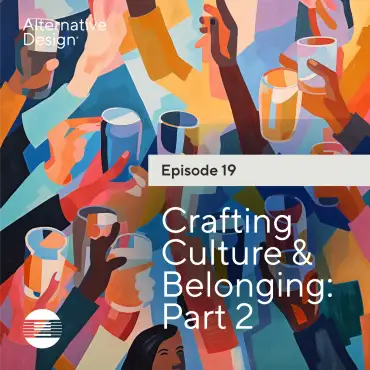One of the biggest challenges facing workplaces is fostering a true sense of belonging among employees.
In the second segment of the Alternative Design podcast Crafting Culture and Belonging episodes, we revealed there are scientific solutions rooted in understanding the evolutionary need to belong and gave our listeners a sneak peek into Kimball International’s research with Arigami.
A SUCCESS STORY ON BELONGING
We returned to Ferndale Project microbrewery to hear from Managing Partner, Dayne Bartscht, about how discovering their authentic values through unforeseen challenges informed the design of the taproom, which became a beacon for inclusion and belonging in the Ferndale community. In navigating the pandemic, Ferndale Project emerged stronger by “spreading kindness”, “being intentional”, and “staying scrappy”, showing how adversity sometimes clarifies an organization's essence. The design of the taproom allowed these values to truly shine, highlighted by a variety of space types where folks could congregate based on shared interests or life experience. This grassroots success presents a model for business leaders striving to nourish belonging in the office, which is tied to higher engagement, job performance, and overall success.
IDENTIFY CULTURE AS A PRECURSOR TO DESIGN
What are the practical ways designers can translate culture into workplace design? Ari Peralta, Founding Partner at Arigami and Harvard Sensory Designer and Neuroscientist, returns to the show to reveal a sneak peek of the findings from Kimball International’s latest behavioral study conducted in partnership with Arigami. Peralta discusses captivating insights about the link between belonging, culture, and furniture to empower designers with evidence-based solutions to bolster a sense of belonging. He explains the five culture types that can help designers begin with a framework for belonging: Classic, Collective, Harmonizers, Trailblazers, and Adaptors.
CREATE MULTIPLE SPACE TYPES FOR EMPOWERMENT
Kimball International’s research with Arigami also uncovers a significant link between the six space types discovered through Kimball International’s research with Ipsos and people’s sense of belonging at work. The greater the variety of space types present in an individual’s workplace, the stronger their sense of belonging. By including these six space types in a facility, organizations can offer choice and nurture feelings of connection, community, and comfort, empowering everyone to be their best. These space types are: The Hub, Culture Café, Work Your Way, The Meet-Up, Room on the Move, and Well and Good.
Learn More: Six Space Types
TAKE NEURODIVERSITY INTO ACCOUNT
To further increase a sense of belonging, Peralta also outlined the four main categories of neurodiversity in the research that influence sensory preferences and how the brain perceives belonging. They are low registration, sensation seeking, sensory sensitivity, and sensation avoiding. Understanding people in these categories will respond to stimuli in unique ways helps designers to ensure aspects of the design are appropriate for each. Kimball International’s survey included a sensory profile scale that assessed how research participants respond to things like sound, vision, and touch in the built environment. By carefully crafting micro-environments and selecting sensory design components, like atmospheric sound, privacy, lighting, biophilic elements, and ergonomic furnishings, we can enhance workers' belonging when tailored to personal preferences. Choices in color and intensity can make a space feel more welcoming or creatively stimulating, impacting mood and productivity.
Listen to episode 19, Crafting Culture & Belonging: Part 2 to take a deeper dive into Ferndale Project’s success and for a sneak peek into Kimball International’s research with Arigami. Stay tuned for the full body of research.


